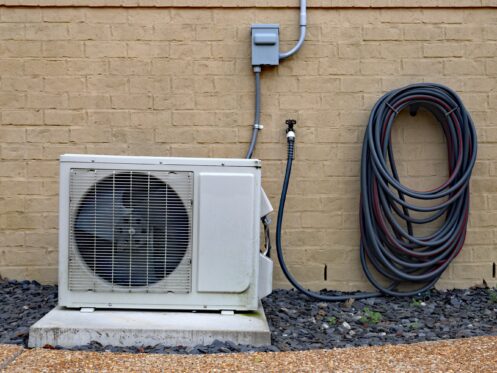If you’re searching for a way to heat and cool your Lincoln, NE home without breaking the bank, you’re not alone. Throughout the nation, HVAC use accounts for half of the average home energy bill. The good news is that ductless mini-splits provide whole-house heating and cooling without costing a fortune to run. Although they’ve been around for decades, ductless mini-split heat pumps are currently gaining popularity for their small carbon footprint, low operating costs, and all-around ease and convenience.
What Is a Ductless Mini-Split?
Just as their name implies, ductless mini-split systems offer heating and cooling services without the need for HVAC air ducts. They’re a top choice for homes that were built without ducting, but they’re also popular for regulating temperatures in rooms that are under-served by existing HVAC equipment. Just like central air conditioners and heaters, these systems regulate both temperature and humidity, and they also provide a measure of indoor air filtration.
Ductless mini-split systems consist of two basic components: an outdoor condenser unit and one or more indoor air handlers. Although a ductless mini-split condenser is smaller than a central air conditioner’s condenser, it serves a similar purpose. This component is typically placed on a small concrete pad in a side yard or backyard. It is then connected to multiple indoor air handlers that are installed throughout the building. These connections are established by running refrigerant lines and electrical wiring through small holes in the exterior walls of all rooms or zones that need service. For most installations, these holes measure just three inches in diameter, and only one hole is needed for each room or zone.
How Ductless Mini-Splits Work
During the summer months, a ductless mini-split heat pump functions just like an air conditioner. This unit uses heat transfer to move warm, indoor air outside. This air is harnessed from the interior of the building and passed over the refrigerant-filled evaporator coil within the air handling unit. The refrigerant within this coil absorbs the air’s heat, and the resulting cooler air is then distributed throughout the space.
Warm refrigerant travels to the outdoor condenser, where its heat is removed and released outside. Once cool, this same refrigerant travels back to the indoor air handler, and the entire process is repeated.
In winter, you can reverse a ductless mini-split heat pump’s operations so that this system gathers warm air from the outside and brings it indoors. This method of heat transfer is far more efficient than burning fuel to create heat. It also eliminates the production of exhaust gases. Thus, with a ductless mini-split heat pump as your primary heat source, you won’t have to worry about carbon monoxide exposure or poisoning.
Get Zoned Heating and Cooling for Customized Comfort
Among the many remarkable attributes of ductless mini-splits is their ability to provide customized temperature and humidity control. Although heat transfer certainly contributes to their impressive efficiency, these systems also earn their reputation for being cost-effective through zoning. With zoning, entire homes are broken up into several service areas. Ductless systems can accommodate up to eight service areas. With each zone having its own air handler and thermostat, building residents can control the climates in their immediate areas independently.
As far as energy saving goes, installing a ductless mini-split is a great way to avoid spending on rooms that are empty. If you have spaces throughout your home that no one is actively using, you can simply turn the air handlers in these areas off.
Sidestep the Energy Losses Caused by HVAC Air Ducts
Just as HVAC systems can account for as much as 50% of a home’s energy use during times of high heating and cooling demand, HVAC ductwork can account for up to 50% of its energy waste. This is especially true during the winter months when heated air must travel through long networks of ducts before being distributed. When HVAC ducting is poorly insulated, aging, or riddled with structural damage, much of this air’s heat is lost along the way.
Leaky ducting can also deposit heated and cooled air in basement areas and crawlspaces, in garages, or behind drywall. Conditioned air that’s lost as a result of duct leaks has no impact on indoor temperatures at all. As a result, both heaters and air conditioners are forced to work longer to get their jobs done.
In comparison, ductless mini-split systems distribute heated and cooled air right where it’s produced. As soon as warm indoor air passes over the evaporator coils of indoor air handlers, it gets routed right back inside. When warm air is extracted from the outdoors, it doesn’t have to pass through long metal tunnels before reaching bedrooms and other living areas. None of its heat is lost and the potential for air leaks is eliminated. Homeowners who choose ductless systems are also able to sidestep the costs of annual ductwork inspections, routine HVAC air duct cleaning, and air duct retrofitting projects.
The Impressive Efficiency of Heat Transfer
Investing in a high-efficiency boiler or furnace is one way to cut your energy bills. The most efficient of these heaters can have annual fuel utilization efficiency (AFUE) ratings as high as 98.5%. This means that they’re capable of converting up to 98.5% of the energy they consume into heat energy. Consequently, only about 1.5% of the energy they use is wasted.
However, despite being impressive, these efficiency ratings cannot compare to those of a top-rated ductless heat pump. Due to their use of heat transfer, some ductless mini-split heat pumps have efficiency ratings of 300% or greater. In the right environments, these units can produce more than three times as much thermal energy as they consume in electric energy. As a result, even if you have to run your heat pump all day long, you’ll hardly notice an increase in your utility bill.
Is a Ductless Mini-Split Right for Your Lincoln Home?
When it comes to efficiency and affordable operation, ductless heat pumps handily trump the competition. There is, however, a caveat. Ductless mini-split heat pumps have their limitations during winter. Given that these units source heat from outdoors, they work best when outside temperatures are above freezing. Some ductless mini-split heat pumps only enjoy high levels of efficiency when outside temperatures are 30 degrees Fahrenheit or higher. Others start experiencing losses in efficiency as soon as outside temperatures fall below 40 degrees Fahrenheit. When this happens, these units run longer and they have a harder time creating the indoor temperatures that building residents want.
If you’re interested in using a ductless mini-split heat pump as the sole source of heat in your Lincoln home, you’ll have to install a high-performance model. These units are slightly more costly than standard ductless heat pumps, but they perform well even when outside temperatures fall below freezing. They’re better suited for whole-house warmth in frosty Nebraska winters, and they’ll provide the greatest savings on your home energy bill over time.
Our team at John Henry's Plumbing, Heating, Air, and Electrical has been serving residents of Lincoln for more than 20 years. We’re committed to helping our clients cut their spending while optimizing their home comfort and safety. We offer ductless mini-split installation, maintenance, and repair services, and we also handle standard air conditioners, boilers, and furnaces. In addition, we provide a complete array of plumbing services. To find out more about ductless mini-splits or to schedule an appointment, give us a call at John Henry's Plumbing, Heating, Air, and Electrical today.

